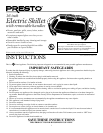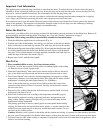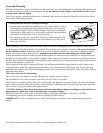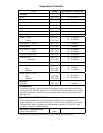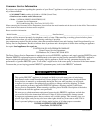
3
Care and Cleaning
With the skillet handles removed, the skillet base and cover easily t in most dishwashers for cleaning. Wash the base and
cover before initial use and after each subsequent use. Do not immerse Control Master
heat control in water or let it
come in contact with any liquid.
Note: If you choose to wash the skillet base in a dishwasher, the bottom of the base will likely discolor due to the caustic
nature of the dishwashing detergent.
To disassemble the skillet for cleaning and storage:
1. Initially, place the skillet base upside down on the counter. Remove each of
the handles by pulling the latch clips back until the clips clear the edge of
the latch clip catches (Fig. B). While holding the clips back, lift the handle
from the base. With practice, you will be able to open the clips and remove
the handles while the skillet is in an upright position.
2. For compact storage, place the handles in the base, positioning them with
the rubber feet up and towards the center of the base (Fig. D). Then place
the cover on the base.
When washing by hand, clean the nonstick surface with a non-metal cleaning pad, such as Scotch-Brite* Multi-Purpose
Scrub Sponge or Scotch-Brite* Dobie* Cleaning Pad. Firm pressure can be applied, if necessary. Do not use steel wool or
abrasive kitchen cleaners. Soaking the skillet to loosen food residue is not necessary. If, however, soaking the skillet is
desired, do not soak for more than two hours. Soaking for more than two hours may damage the nonstick finish.
In time, the nonstick nish may darken over the heating element. To remove this discoloration, use a commercial cleaner
designed for cleaning surfaces, such as dip-it* destainer. These cleaners are available at most grocery and hardware stores.
For best results, follow the manufacturer’s instructions, being careful that any cleaning solution coming in contact with the
exterior of the appliance is wiped off.
After treating the skillet with a commercial cleaner, it is recommended that the cooking surface be wiped lightly with a
cooking oil before using. The outside nish of the skillet is easy to keep attractive and looking new. Simply wipe away
spills and drips as they occur. If food should happen to burn on, it can be removed with warm, sudsy water and a cleaning
pad. Rinse and wipe dry.
Glass Cover Care and Use Instructions
Do not use cover if it is chipped or cracked. Handle cover carefully and avoid impact.
Do not handle hot cover with wet towel or place hot cover on a cold or wet surface.
Allow cover to cool before washing. This cover is dishwasher safe. Keep the cover clean. Do not use steel wool cleaning
pads or abrasive powders which can scratch or weaken the glass. Nonabrasive pads or powders may be used if necessary.
Do not scrape or gouge glass with hard or sharp utensils.
CAUTION: Failure to follow these instructions could cause immediate breakage or breakage at a later date for no
apparent reason, which may result in personal injury or property damage.
Periodically check the screws on the cover handle and legs for looseness. Retighten, if necessary. CAUTION:
Overtightening can result in stripping of screws or cracking of handle and legs.
IMPORTANT: To ensure continued accuracy of the Control Master
heat control, avoid rough handling in use and
storage.
*Scotch Brite and
Dobie
are trademarks of 3M;
dip-it is a registered trademark of Ecolab, Inc.
Rubber feet
Fig. D



